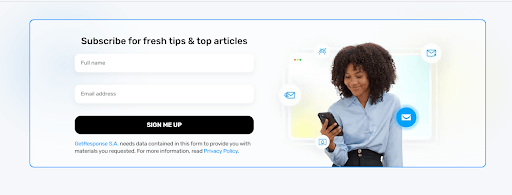5 Most Effective Marketing Ideas for Small Businesses

Contents
It’s already established that marketing can drive awareness and fuel business growth. That’s one reason to get it right as a small business owner.
Effective marketing strategies can bring new customers, help retain old ones, build your reputation, and set you apart from competitors.
Now, the early stages of marketing might involve trial and error, but knowing where to focus your efforts can make a significant difference in your results. So, today, we present 5 high-performing small business marketing ideas to get you going.
Here we go.
1. Create a Functional, Mobile-Friendly Website
A functional, mobile-friendly website is one non-negotiable necessity for your small business. This is because your website serves as a digital front that customers visit to learn about your business and make purchases.
What does a functional website look like?
For one, the website prioritizes positive customer experience and is easy to navigate. Visitors can find clear information about your products or services and there’s a straightforward way to buy products or reach you if they have questions.
Your website should be mobile-friendly— that is, the site renders well on devices like smartphones and tablets. This is important because about 92.3% of users surf the net with smartphones.
A good way to create a remarkable small business website is to aim for simplicity. Use a site builder like GetResponse which has nice templates and drag-and-drop components that make it easy for non-technical users to build professional-looking sites. They also provide responsive layouts that further optimize your site’s design.
Key things to have on your website include:
- A homepage that clearly states what you offer
- An “About Us” page to tell your story
- A products or services page — with detailed descriptions about each of your products or services
- A contact page
Make your web copy readable. Avoid using fonts that are too fancy, small, or hard to decipher.
Include a prominent menu for easy navigation, and strategically place call-to-action buttons throughout the site to guide visitors towards desired actions. Common CTA examples include “Buy Now,” “Contact Us,” or “Learn More.”
To ensure that your site loads quickly, use image formats like PNG, JPEG, or SVG. Upload smaller file sizes— something between 100KB and 500KB is decent. Also, use lazy loading which ensures that your images are only loaded when they are about to be seen by the user. A tool like Nostra AI can also help you improve your site performance. You can also use a reputable hosting provider like ScalaHosting, which provides high-performance web hosting.
It’s okay to seek professional help, especially with the technical aspects of building your business website.
2. Create and Optimize Google My Business Account
A Google Business account is also important to enhance your online presence. Creating a Google Business account can improve your visibility on search engines and Google Maps. This, in turn, can lead to more foot traffic, phone calls, and website visits.
When prospects search for products or services you offer, there’s a high likelihood that your business profile will appear among the search results. For instance, see how local stores show among Google search results for “flower vases.”
Setting up a Google Business account is straightforward.
Go to the Google Business website and click “Manage now.”

Enter your business name, then choose the relevant business category. Click Next and follow the other prompts.
Ensure your address, phone number, website URL, and opening hours are accurate and up-to-date.
How to optimize your Google business account:
- Write a comprehensive business description that includes relevant keywords (we’ll show you how to find these keywords later).
- Upload high-quality images of your business exterior, interior, and products.
- Add your logo and cover photo to make your listing visually appealing.
- Regularly post updates, offers, and events to keep your profile active.
Finally, encourage loyal customers to leave reviews. It’s also nice to respond promptly to all feedback— both negative and positive reviews.
Note: You should claim and verify your business profile. The verification can be done through phone, text, email, or video. Once verified, you can keep managing your listing.
3. Publish SEO-Friendly Content
Search engine optimization (SEO) is a content marketing tactic that targets high search engine rankings.
SEO-friendly content is often well-structured and includes relevant keywords that potential customers use when searching for products or services.
To create SEO-friendly content, first identify your target customer base and the topics they’re interested in. Consider the most common or generic phrases associated with your business. If you run a B2B cleaning service, for instance, these could include phrases like “cleaning company in Kentucky” “janitorial services” “office cleaning services” etc. Make a list of these words or phrases.
After you’ve made a list, you can use keyword research tools like Google Keyword Planner, Ubersuggest, or SEMrush to find related and relevant terms.
See an example if we search for “office cleaning services” on Google Keyword Planner:

In your results, you’ll find data about the search volume and competition (high, medium, or low). Start with keywords that have a high search volume and low-medium competition. These keywords are often easier to rank for if you’re new to SEO. After a while, you can start targeting more competitive keywords.
Once you’ve identified your keywords, incorporate them naturally into your content, and include the keywords in your:
- Blog titles
- Headings
- Body text
- Image descriptions and alt texts
- Meta descriptions text
Avoid keyword stuffing, as this can negatively impact your rankings. Focus on creating high-quality, valuable content that addresses your audience’s interests. Do this through different blog posts like:
- How-to guides or listicles
- Product reviews
- Industry news, etc.
The goal is to provide useful information that establishes your business as an authority in your field.
For local SEO, include location-specific keywords and create content relevant to your local community. This might involve writing about local events, featuring local customer reviews, or addressing region-specific topics.
4. Execute Email Marketing Campaigns
Email is another marketing channel you should maximize. According to DMA, you can get up to $38 return on investment for every $1 spent on email marketing.
Start your email marketing by curating an email list. You can do this by adding sign-up forms to your website or using pop-up forms that appear after a visitor has spent time on your page.
Here’s an example:

You can also collect email addresses through contact forms on your website. Consider creating a dedicated landing page for email sign-ups, and offer a lead magnet – like a free e-book, discount code, or cheat sheet— to incentivize subscriptions.
Also, if you attend networking events, consider using digital business cards to collect email addresses and store them in your CRM. Tools like Uniqode can help with business cards that integrate with your CRM.
Your email marketing strategy will be more impactful if you segment your list. This way, you’ll be sending more personalized and relevant content. Segment your subscribers by
- Gender
- Location
- Business type, or other shared attributes.
Set up automated email drips to maintain consistent engagement. These can include welcome emails for new subscribers, follow-up messages after purchases, and promotional emails for your products or services.
Keep your marketing email content concise. Use clear, attention-grabbing email subject lines to improve open rates. Make your call-to-action buttons prominent. And, use a clean design that’s consistent with your brand. The best email newsletter software solutions come with stunning pre-built email templates you might want to consider using.
Consider using cold email campaigns to connect with prospects yet to discover your business. Email finder tools like ViolaNorbert, Data Finder, or GetProspect can be useful here.
Adhere to email marketing guidelines like CAN-SPAM, and GDPR. These regulations require you to include your physical address in every email, provide an easy-to-use unsubscribe mechanism, avoid spamming, and prioritize customer privacy.
5. Adopt Social Media Marketing
Social media marketing is a must-add to this list of small business marketing ideas. Platforms like Instagram, Facebook, LinkedIn, and X can help you connect with potential customers and build brand loyalty. Use them.
Create and optimize your social profiles with a compelling bio that includes a clear description of your business.
To unify your online marketing efforts, maintain a consistent brand image across all your social media accounts. Start with one platform where your target audience is most active, and master it before expanding to others.
Focus on creating engaging social media content that resonates with your target customers. Share behind-the-scenes glimpses, product highlights, and valuable tips related to your products or services.
Stay current with trends using tools like Monster or HootSuite can help you see. Thanks to algorithms, you can know what’s trendy by observing what keeps popping into your feed. Don’t shy away from using popular features like Stories, Reels, or Live videos in your social media posts. You can also collaborate with social media influencers or other social accounts with a similar target audience.
Create a social media calendar and plan your posts for better consistency. Use a simple spreadsheet or opt for dedicated social media management tools like Later or Sprout Social.
Finally, run targeted social media ads to reach users with specific demographics, interests, and behaviors that align with your ideal customer profile. Start with a small marketing budget. Also, experiment with different ad formats and messaging to see what drives the best results. In due time, you’ll build a strong social media presence that attracts and retains customers— ultimately growing your small business.
Conclusion
A thorough marketing plan can set up your small business for good. The goal is to help customers find you across key touch points— and get them to patronize you.
As we round up, let’s go over the small business marketing ideas you’ve learned about. First, create a functional, mobile-friendly website. Set up your Google Business account and optimize it. Publish SEO-friendly content, run email campaigns, and use social media marketing.
With these effective tactics, get ready to see an increase in your reach and visibility.
***** This is a guest post from Michal Leszczynski. Michal is the Head of Content Marketing and Partnerships at GetResponse. With 10+ years of experience, Michal is a seasoned expert in all things online marketing. *****





